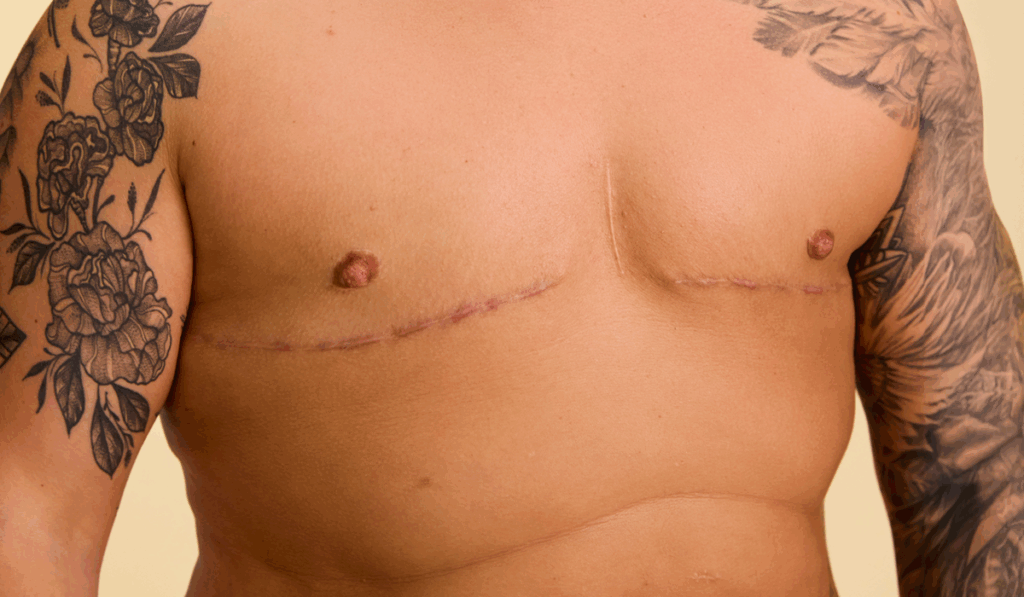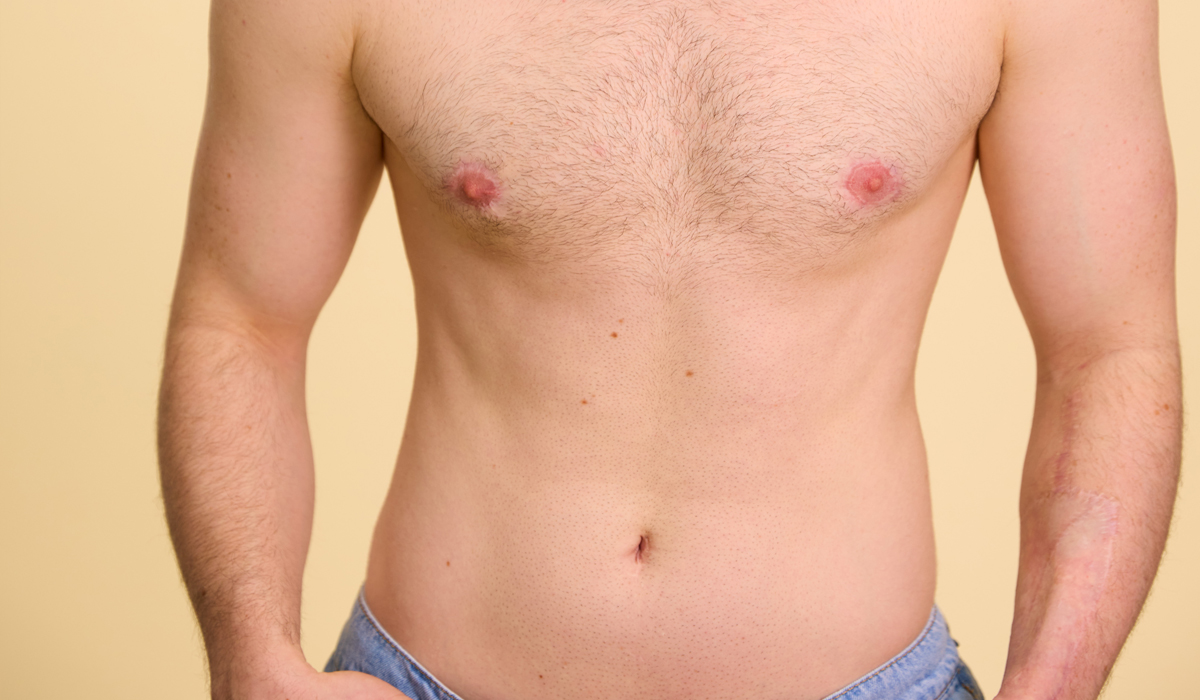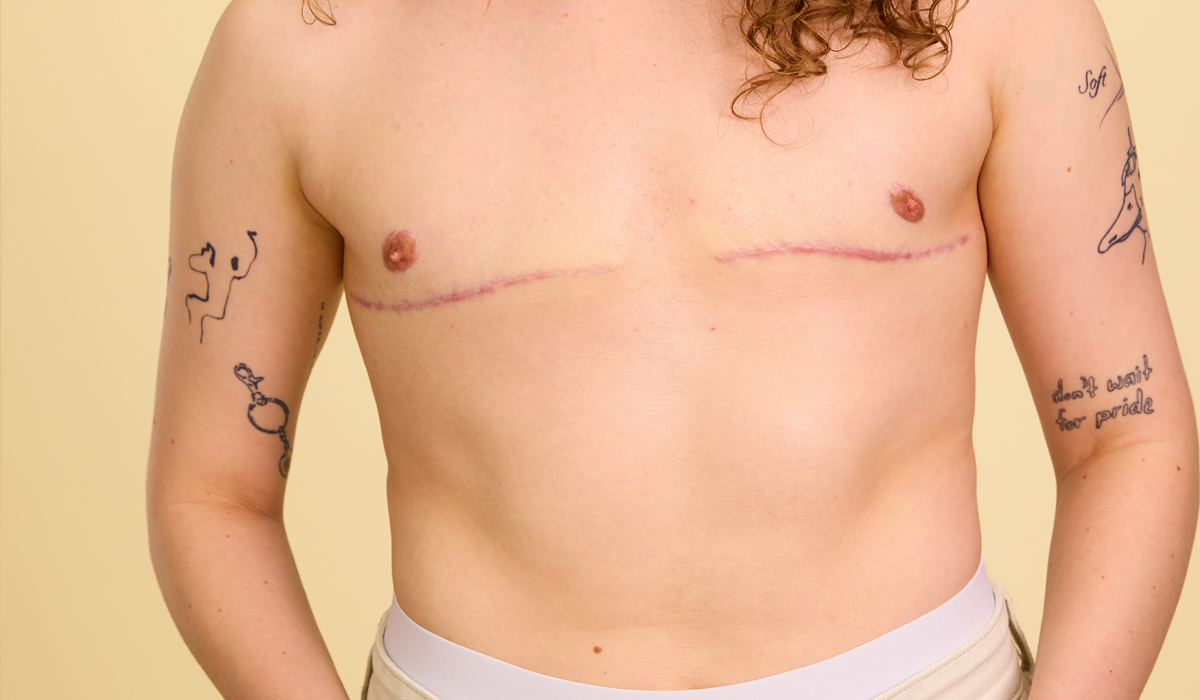Top surgery for dysphoria: a crucial step toward self-determination and quality of life
Top surgery is a surgical procedure that plays an important role for many transmasculine, non-binary and gender-diverse individuals on their journey to gender affirmation. It offers the opportunity to shape the upper body in a way that is more consistent with one's gender identity, thereby alleviating physical dysphoria. This procedure is an important step towards a self-determined and physically harmonious life. However, dysphoria may also occur in cis women, i.e. women whose gender identity corresponds to the sex assigned at birth.
Mastectomy
 © Sophia Emmerich, Berlin
© Sophia Emmerich, Berlin Depending on the shape of the breasts, breast volume, skin elasticity and the desired result, various surgical procedures are available for mastectomy, including the periareolar technique, the double incision method, or procedures with or without nipple relocation (nipple grafts).
The choice of the most suitable procedure is tailored to the individual’s expectations, based on medical criteria as well as personal goals. In addition to physiological aspects such as tissue quality, previous illnesses and prior operations, we also take psychological factors into account, such as the extent of the dysphoria experienced, expectations as to the surgical outcome and the desire for bodily harmony.
Information
- Treatment Duration
- 1.5 to 2.5 h
- Anaesthesia
- General (additional local Anaesthesia)
- Hospital Stay
- 1 to 2 Nights
- Recovery Period
- 2 to 3 Weeks
- No Sports
- 6 Weeks
- Costs
- starting at approx. 6,500 €*
- Information on Cost Coverage
*) plus Anaesthesia costs
Surgical Methods
 © Sophia Emmerich, Berlin
© Sophia Emmerich, BerlinKeyhole-Methode
A scar-reducing technique for small breasts with good skin elasticity. The glandular tissue is removed through a small incision at the edge of the areola.
 © Sophia Emmerich, Berlin
© Sophia Emmerich, BerlinNon-Flat Top Surgery
A radical breast reduction in which volume and breast contour are intentionally preserved. For a less feminine but not completely flat appearance.
 © Sophia Emmerich, Berlin
© Sophia Emmerich, BerlinDouble-Incision Mastectomy
The standard procedure for medium to large breast volumes. Skin and glandular tissue are removed; the nipples are typically reduced in size and repositioned as grafts.
Looking for personalized advice?
AppointmentWe take time to address your questions, wishes and concerns. You’ll receive transparent information about the procedure, its opportunities, risks, and possible complications.
Meet Michelle
Support, answers, and real experience with Top Surgery
Michelle isn’t just our patient coordinator - she’s also undergone a mastectomy with us herself. Thanks to her own experience, she truly understands your concerns, fears, and hopes. With empathy and insight, she’ll guide you through every step of the process — from your first consultation to aftercare. Your go-to person for all your questions or concerns.
Get in Touch
Michelle
Our expert for all things Top Surgery
Get to know me: michellexofficial
Questions about the Procedure
What does Breast dysphoria mean?
Breast dysphoria, often described as a form of gender dysphoria, refers to discomfort or dissatisfaction with one’s own breasts. This type of dysphoria may affect cis women or transgender individuals. The effects may vary, but common experiences include:
Physical discomfort: A pronounced aversion or even physical discomfort in relation to the breasts. This can result in feelings of disgust, pain or shame. In some cases, the intensity may interfere with daily life.
Psychological effects: Breast dysphoria may cause ongoing stress, anxiety or depression. The constant feeling that one’s body does not align with one’s gender identity can deeply affect self-esteem and well-being.
Avoidance of physical contact: Some individuals avoid showing their chest or having physical contact involving the chest, such as hugging or wearing certain types of clothing. Tight-fitting garments or specific activities may also be avoided to prevent attention to or awareness of their chest.
Clothing and appearance: Clothing choices play an important role. Many individuals with breast dysphoria wear loose or baggy clothing to conceal their breasts. Some opt to wear a binder to flatten their chest in order to feel more comfortable.
Medical procedures: For some, surgical treatment, such as breast removal (mastectomy), may offer relief from this dysphoria. This procedure is particularly common among trans men or non-binary individuals who feel that their breasts do not align with their gender identity. Cis women may also undergo surgery when dysphoria becomes overwhelming.
The impact of breast dysphoria is highly individual and can vary in intensity. It is important that individuals affected by breast dysphoria have access to therapeutic and medical support.
What is Top Surgery?
Top surgery usually involves the removal of breast tissue and the reconstruction of the chest area to create a flat, masculine contour. For many individuals experiencing breast dysphoria, this procedure represents a crucial step toward overcoming physical dysphoria. Unfortunately, many individuals with breast dysphoria, whether trans men, non-binary individuals or even cis women, access to medical options often comes only after a long period of distress. This lengthy process may be due to various reasons, such as:
Lack of understanding and stigma: In many societies, there is still a lack of understanding of the experience of dysphoria and the needs of those affected. The medical field has also considerable time to recognize dysphoria as a legitimate and treatable condition. As a result, many do not receive the support or resources they need to cope with their dysphoria.
Access to healthcare services: In many countries or regions, comprehensive medical care for people with dysphoria is limited or unavailable. Waiting times for counselling, psychological care or surgical procedures can be long and inaccessible, prolonging the suffering. Cost for such measures may also pose a barrier.
Psychological and emotional distress: The path to accessing medical interventions such as breast surgery (e.g. mastectomy) can be emotionally demanding. Individuals often need to validate their identity and their wish for treatment — a process that may include extended psychological evaluations or proof of long-standing dysphoria. This may further delay the process and increase feelings of uncertainty or frustration.
Legal and bureaucratic hurdles: In some countries or states, legal and bureaucratic obstacles can make access to medical treatment difficult. Individuals may face a long and complex process before receiving the care they need.
Stigma and Fear of Rejection: Many individuals fear that their desire for medical support will be dismissed or not taken seriously. Especially in less open societies or unsupportive medical environments, this can lead to significant hesitation when it comes to seeking help.
What are the Requirements for Top Surgery?
Clear Desire for Mastectommy: The most important prerequisite for performing top surgery is a clear and deliberate desire for a mastectomy. The decision to take this surgical step must be carefully considered and based on the need to achieve physical alignment with one’s gender.
Letter of Indication: In certain cases, a letter of indication is required from a psychologist or specialist confirming gender incongruence or dysphoria and recommending surgical intervention. Whether this assessment is needed depends on various factors and will be discussed during the initial consultation with your specialist.
Consent for minors: For individuals under 18 years of age, written consent from a legal guardian is required in addition to the letter of indication. This ensures that your family is involved in the decision-making process and will provide you with appropriate support.
Preliminary examinations: Prior to surgery, our experienced medical team will determine with you during consultation whether further medical examinations are necessary. These may vary depending on your previous medical history and help to ensure optimal preparation for the procedure. It is also important to disclose any current medications, especially to account for potential interactions with anesthesia or postoperative prescriptions.
Ultrasound examination of the breast: A breast ultrasound examination must be performed in all cases to confirm that the breast tissue is normal at the time of the surgery. This examination should be conducted no more than three months prior to the scheduled operation to ensure that the results are accurate and reliable.
Hormone Therapie: For those considering hormone therapy and seeking coverage from health insurance providers, it is adviseable to begin 6-12 months before surgery. However, it should be noted that hormone therapy is not a mandatory prerequisite for the procedure itself.
What happens after the initial consultation?
Following a detailed initial consultation, we will decide together which steps are necessary to prepare for the procedure best suited for you. Our goal is to make the process as straightforward as possible and while providing you with comprehensive guidance and support on your journey toward the desired transformation.
Ready for the next step?
If there are further questions about the requirements for top surgery or interest in learning more about the procedure, a non-binding consultation can be scheduled at any time. Our team is available to provide support and information.
What Surgical Techniques are available for Top Surgery?
Top surgery includes IMF mastectomy, periareolar mastectomy and non-flat top surgery. The choice of technique and incision depends on various factors such as skin elasticity, breast size, body shape, fat distribution and personal treatment goals.
1. IMF Mastectomy (Inframammary Fold Technique)
The IMF mastectomy is statistically the most commonly performed procedure. It is particularly suitable for individuals with excess skin and more developed breasts. Two horizontal incisions (double-incision mastectomy) are typically made directly in the natural breast fold beneath the nipples. The entire breast tissue is removed and the remaining excess skin is tightened. In some cases, a continuous incision is necessary (one-incision mastectomy).
The most suitable incision technique is explained individually during our consultations and discussed in detail with you to achieve the best outcome.
2. Periareolar Mastectomy (Keyhole Technique)
The periareolar mastectomy, also known as the keyhole technique, is a minimally invasive method in which the incision is made either in a crescent shape at the lower edge of the areola or completely around the areola. This technique allows for the removal of breast tissue without producing a large scar. It is especially suitable for individuals with small breasts minimal excess skin.
3. Non-Flat Top Surgery
Non-flat top surgery is suitable for those seeking a significant reduction in breast size while retaining as much of a natural round shape as possible. This method aims to achieve a significantly more athletic breast contour while preserving a certain amount of breast tissue.
This radical breast reduction uses an inverted T-shaped incision pattern (T-incision or inverted T). The T-incision is necessary to remove substantial amounts of skin and tissue while creating a harmonious contour and shape stability.
Procedure:
Incision: The T-incision consists of three main incisions:
- A horizontal incision along the crease beneath the breast
- A vertical incision running downward from the nipple
- An incision around the nipple
Tissue Removal: Excess breast tissue, fat and skin are removed to reduce and lift the breast.
Reconstruction: The nipple area is repositioned, and the remaining skin is tightened to give the breast its new, smaller shape.
What happens to the Nipples during Top Surgery?
Some individuals choose to keep their nipples, while others do not. This depends on personal preferences and physical characteristics.
Retention of the Nipples:
In many mastectomies, especially with the periareolar technique (keyhole technique) and non-flat top surgery, the nipples are typically preserved, as they are often considered an important aspect of body identity.
The nipple is being cut around and the underlying breast tissue is removed, allowing it to remain in position. Sometimes the areola (the pigmented area around the nipple) is reduced for aesthetic refinement.
In IMF mastectomy, nipple transfer is often performed:
the nipple-areola complex is detached from the chest wall, resized and repositioned to achieve a natural-looking appearance.
Removal of the Nipples:
Some indivduals undergoing mastectomy choose not to retain their nipples. This may be due to various reasons: aesthetic or personal preference, or a desire for a completely smooth, chest-flat result.
In full breast removal, performed using the inframammary fold (IMF) technique, the nipples can be removed without resulting in additional scarring.
Medical Pigmentation:
Medical pigmentation of the areola and nipple (nipple-areola complex = NAP) is a common option for those who wish to restore the aesthetic appearance after a mastectomy without nipple transfer. This method is also ideal for refining the colour and shape of a transplanted or pedicled nipple affected by wound healing issues. This should always be performed by a qualified professional.
Reconstruction
Some individuals chose to have their nipples reconstructed at a later stage.
What is the Follow-up Treatment and Healing Process after a Mastectomy?
To support healing and reduce pain and swelling, wearing a compression vest is required for approximately six weeks after the mastectomy. This ensures optimal skin healing and helps minimize post-operative swelling, promoting a flat and even contour. We will inform you in good time in good time ahead of top surgery about where to obtain the compression vest.
The removal of dressings and sutures takes place during scheduled check-ups at our clinic or, alternatively, at your General Practitioner’s office. In this case, we will of course provide you with detailed written instructions.
Wounds should only be treated with wound cream or care oil after the stitches have been removed. Special scar care products may be used only once all scabs have fallen off, helping support healing and improve scar appearance.
For smooth and complication-free recovery, physical activity and heavy lifting should be avoided for at least six weeks. Mechanical strain on the upper body may lead to the formation of seromas – accumulations of fluid in the wound cavity. Stretching the scars unnecessarily may cause them to widen.
We will provide detailed guidance on scar care and optimal healing during your follow-up appointments. However, the final result of the procedure may only be assessed after six months during the final post-operative check-up.
What Options are available for Scar Correction after Top Surgery?
After a mastectomy, scars and excess skin, particularly so-called “dog ears”, may be an unwanted outcome of the procedure. Scar correction provides effective options for improving the external appearance. At our clinic, we will be happy to advise you on scar correction so that you can achieve the result you desire.
Excision of the scar or excess skin and soft tissue
A proven method of scar correction following mastectomy is the excision of excess skin or soft tissue, often referred to as “dog ears”. This approach is particularly suitable when noticeable, protruding areas of skin remain after the healing process.
During this surgical procedure, excess tissue is precisely removed and the scar reshaped to blend more harmoniously with the surrounding skin. This procedure is commonly performed on an outpatient basis under local anaesthetic. After the procedure, we recommend wearing a compression garment for two weeks. Physical activity should be avoided during this time.
Minimally invasive measures for hypertrophic scars
In cases where hypertrophic scarring has developed — meaning the scar has become thickened or raised — gentle, non-invasive treatment options are available.
One effective method is corticosteroid injection. Here, anti-inflammatory medication is injected directly into the scar to reduce excess collagen formation and soften and flatten the tissue. This treatment is particularly beneficial if your scar has hardened, thickened and feels uncomfortable during healing.
To achieve visible improvement, the injections are typically administered 2–3 times at intervals of 3–6 weeks. After each session, sports, sun exposure and sauna use should be avoided for 24 hours.
How much does Top Surgery cost?
The cost of top surgery alone ranges between EUR 6,500 and EUR 7,900. A detailed cost estimate is provided, covering the surgeon’s fee, hospital stay, medical supplies, inpatient nursing care and all follow-up appointments.
Additional costs not included in the estimate should also be taken into account.
These may include anaesthesia, a compression vest, follow-up insurance, travel expenses, and – if needed – accommodation for accompanying persons.
Terms of Payment: The surgical costs must be paid in advance. Direct financing or instalment payment plans are not available through our clinic. However, there are providers specializing in financing body contouring procedures. Information and contacts for suitable financing partners can be provided on request.
What sets the Plastmed Duesseldorf team apart?
Professional expertise and quality at the highest level
Even before establishing the private practice and clinic in Düsseldorf, the team worked at one of Germany’s largest centres for plastic breast surgery – performing between 250 and 300 procedures annually on transmasculine and non-binary individuals.
Over the past 15 years, we have continuously refined techniques and treatment concepts with the goal of achieving the best possible outcomes.
What to expect from us:
- Fine, symmetrical and discreet scars, regardless of the initial breast size
- Individual chest contours, tailored to your personal preferences – whether masculine, androgynous or athletically rounded
- High level of safety standards thanks to structured procedures and short operation times
- Comprehensive support during recovery with regular follow-up appointments, clear care instructions and continuous team availability
„The path to gender-affirming surgery is deeply personal. Our commitment is to be emotionally present and to deliver medical excellence.“

Board-Certified Specialists in Plastic and Aesthetic Surgery
Reviews
These reviews were shared by individuals who rated our services on independent platforms. As some chose to post under pseudonyms, we are currently unable to verify their authenticity.
Your next Steps
 © Stephan Wieland, Düsseldorf
© Stephan Wieland, Düsseldorf - Book a non-binding consultation – either as a video call or an in-person appointment. We will take a first look at your needs and answer all your questions. You will receive detailed information about the procedure, including potential risks, the process, and expected costs.
- Following your initial consultation, we will send you all relevant documents via email. Please review them carefully and jot down any questions. If anything feels unclear or uncertain, you’re welcome to reach out at any time.
- Request your surgery date once you feel ready.
- Schedule a second in-person consultation to discuss final details and ensure everything is clear.
- Ask us anything – we’ll take time to address all your questions and provide clarity.
Interested in a personal consultation?
Would you like a personal consultation – either in person or via video call? We offer confidential, non-binding appointments to help you explore your options.:
- Conducted by a board-certified specialist
- Private one-on-one consultation
- Discussion of your goals, methods, and treatment costs
- Fee for initial consultation: € 50
- Optional: Video consultation available


